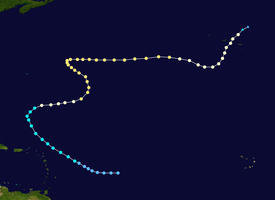 Emmy near peak intensity | |
| Meteorological history | |
|---|---|
| Formed | August 20,1976 |
| Dissipated | September 4,1976 |
| Category 2 hurricane | |
| 1-minute sustained (SSHWS/NWS) | |
| Highest winds | 105 mph (165 km/h) |
| Lowest pressure | 974 mbar (hPa);28.76 inHg |
| Overall effects | |
| Fatalities | 68 indirect |
| Areas affected | Lesser Antilles,Azores |
| IBTrACS | |
Part of the 1976 Atlantic hurricane season | |
Hurricane Emmy was the longest-lived hurricane of the 1976 Atlantic hurricane season. The fifth tropical cyclone and the third hurricane of the season,Emmy developed from a tropical wave on August 20 to the east of the Lesser Antilles. After changing its direction three times over several days,during which it reached a peak intensity of 105 mph (169 km/h),it turned to the east and slowly weakened. Emmy passed through the Azores on September 3,and a day later it was absorbed by approaching Hurricane Frances.
Contents
Emmy passed within 135 miles (217 km) of the Lesser Antilles,though only minor effects were experienced. No damage was reported in the Azores,though strong winds from the hurricane caused a Venezuelan air force Lockheed C-130 flight to crash near Lajes Field,killing all 68 aboard.


